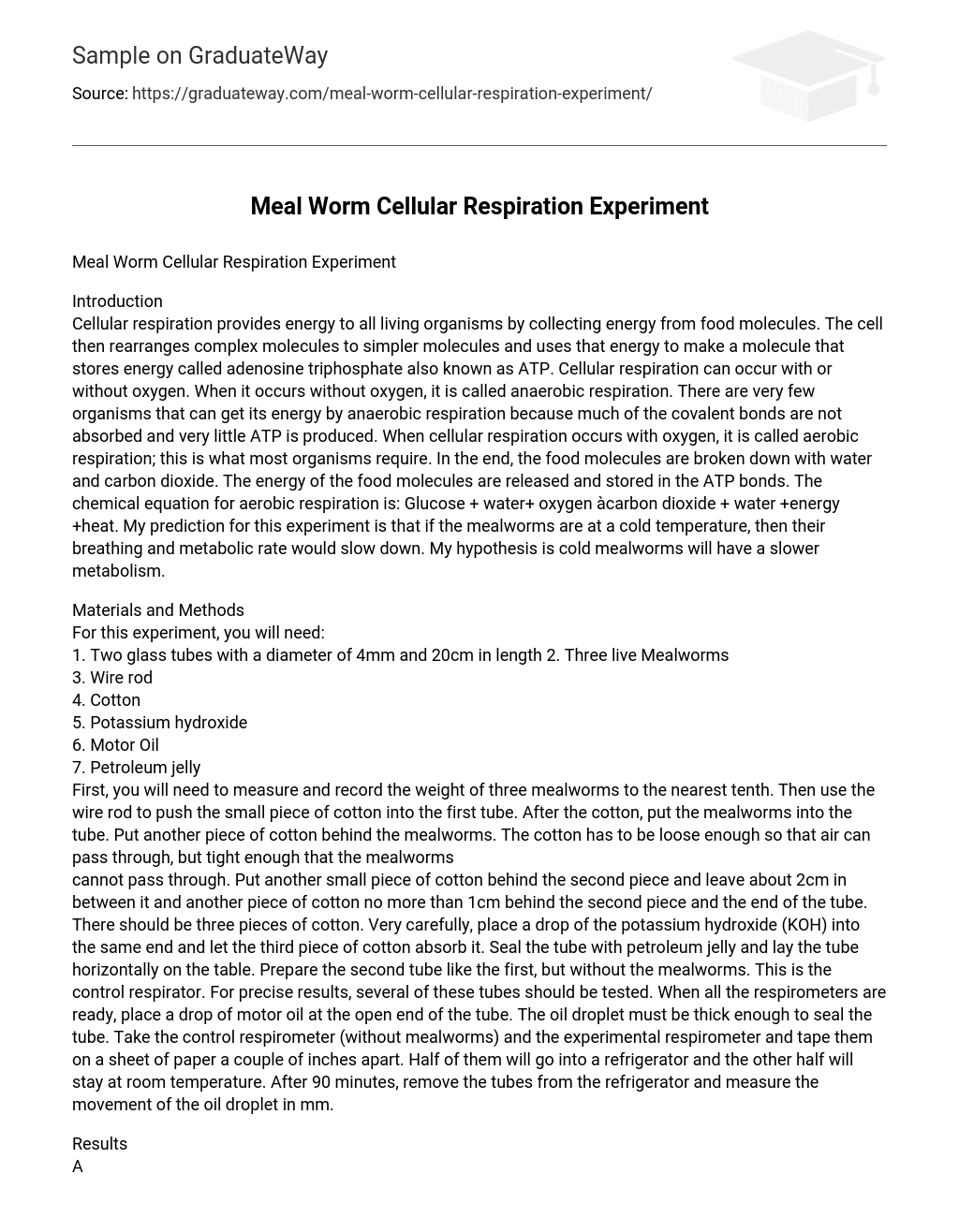Introduction
Cellular respiration provides energy to all living organisms by collecting energy from food molecules. The cell then rearranges complex molecules to simpler molecules and uses that energy to make a molecule that stores energy called adenosine triphosphate also known as ATP. Cellular respiration can occur with or without oxygen. When it occurs without oxygen, it is called anaerobic respiration. There are very few organisms that can get its energy by anaerobic respiration because much of the covalent bonds are not absorbed and very little ATP is produced. When cellular respiration occurs with oxygen, it is called aerobic respiration; this is what most organisms require. In the end, the food molecules are broken down with water and carbon dioxide. The energy of the food molecules are released and stored in the ATP bonds. The chemical equation for aerobic respiration is: Glucose + water+ oxygen àcarbon dioxide + water +energy +heat. My prediction for this experiment is that if the mealworms are at a cold temperature, then their breathing and metabolic rate would slow down. My hypothesis is cold mealworms will have a slower metabolism.
Materials and Methods
For this experiment, you will need:
1. Two glass tubes with a diameter of 4mm and 20cm in length 2. Three live Mealworms
3. Wire rod
4. Cotton
5. Potassium hydroxide
6. Motor Oil
7. Petroleum jelly
First, you will need to measure and record the weight of three mealworms to the nearest tenth. Then use the wire rod to push the small piece of cotton into the first tube. After the cotton, put the mealworms into the tube. Put another piece of cotton behind the mealworms. The cotton has to be loose enough so that air can pass through, but tight enough that the mealworms
cannot pass through. Put another small piece of cotton behind the second piece and leave about 2cm in between it and another piece of cotton no more than 1cm behind the second piece and the end of the tube. There should be three pieces of cotton. Very carefully, place a drop of the potassium hydroxide (KOH) into the same end and let the third piece of cotton absorb it. Seal the tube with petroleum jelly and lay the tube horizontally on the table. Prepare the second tube like the first, but without the mealworms. This is the control respirator. For precise results, several of these tubes should be tested. When all the respirometers are ready, place a drop of motor oil at the open end of the tube. The oil droplet must be thick enough to seal the tube. Take the control respirometer (without mealworms) and the experimental respirometer and tape them on a sheet of paper a couple of inches apart. Half of them will go into a refrigerator and the other half will stay at room temperature. After 90 minutes, remove the tubes from the refrigerator and measure the movement of the oil droplet in mm.
Results
After taking the tubes out of the refrigerator, we compared the class results. The average oxygen consumption rate of the room temperature tubes were 6.9 Three of them were left at room temperature, while four were in the refrigerator. We found that the worms that were in the refrigerator had a significantly slower oxygen consumption rate than those that were out at room temperature.
Discussion
This exercise allowed me to compare the oxygen consumption rates of mealworms at room temperature with those at a colder temperature. The oxygen consumption measured the metabolic rate of the mealworms by measuring the movement of the oil bubble. Mealworms are poikilothermic, meaning that their body temperature varies with the temperature of its surrounding. Because mealworms are cold-blooded organisms, they cannot warm themselves and keep its metabolism up. If a homeothermic organism was put in a freezer, it would be able to warm itself up. For instance, if we had put a human in the refrigerator, the body would shake and shiver in attempts to warm itself up because it is warm-blooded, it will not adapt the temperature around it
as the mealworms did. The results of the human metabolism would might not have been as significant as the results of the mealworms because the body would have warmed itself up, but I would assume that the metabolic rate would have still bee slow. There was a slight problem with the data for the refrigerator 4 group. The experimental respirometer was significantly higher than the other ones, but it wasn’t has high as the room temperature ones. There might have been a problem in the way it was measured or the cotton might have been pushed too far back and did not allow enough space for some air to get to the mealworms.
Conclusion
My prediction was supported by this experiment and my hypothesis is accepted. The mealworms metabolism slowed down in the cold temperature. I learned from this experiment that not all organisms can warm themselves up like humans can and some organisms will adapt to the temperature of its environment.





